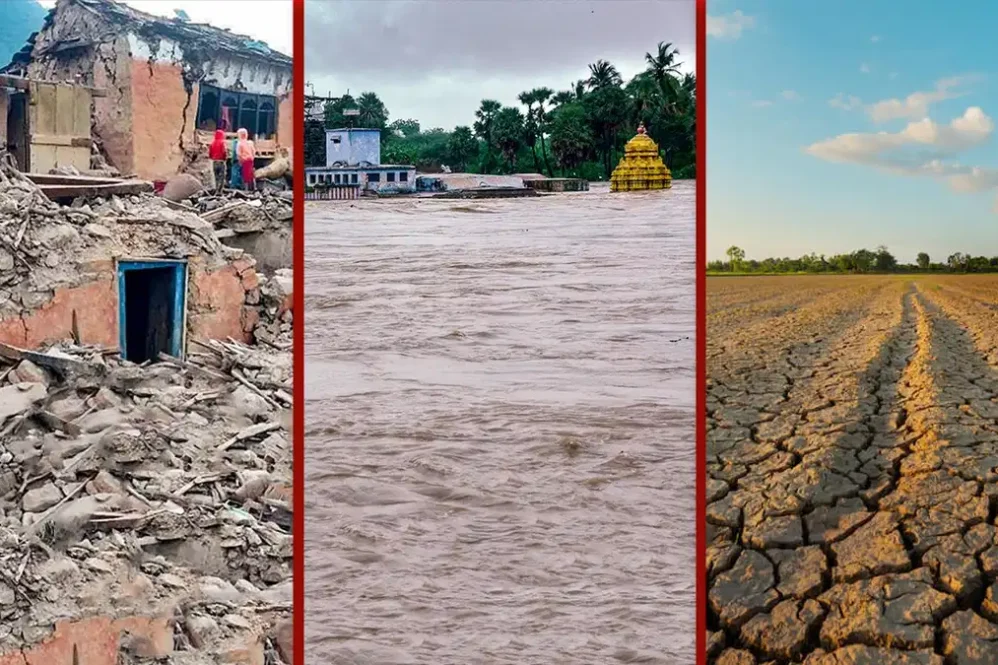Delhi, January 16, 2025: After a benign 2022, natural catastrophes caused significant losses of $12 billion (over Rs 1 lakh crore) in India in calendar year 2023.
Floods in northern India and Sikkim, coupled with tropical cyclones (TC) Biparjoy and Michaung, pushed overall economic losses for the year to $12 billion, well above the previous 10-year (2013-2022) average of $8 billion, global insurance giant Swiss Re said in a report. Economic losses in 2024 are yet to be calculated.
Swiss Re said the high losses were the result of disasters striking areas of large exposure and asset concentration.
For example, the Category 3 TC Biparjoy made landfall in Kutch, Gujarat on June 16, 2023, shutting down all ports in the Saurashtra and Kutch regions including Kandla and Mundra ports.
trong winds, heavy rainfall, and storm surge caused large-scale damage in the state. The cyclone also impacted the neighbouring states of Maharashtra and Rajasthan, it said.
Likewise, TC Michaung, which made landfall on December 5, 2023, brought extreme rainfall that caused large losses in Chennai.
“Floods caused by heavy rains in northern India between July 10-15, 2023 impacted Himachal Pradesh, including the town of Shimla, and Delhi,” Swiss Re said.
According to the Swiss Re, analysis of natural catastrophe-related losses in India over the last two decades shows that floods have accounted for, on average, about 63 per cent of total annual economic losses. This is due to the climate and geography of the country.
“India is under the sway of summer monsoon from June to September, and northeast monsoon from October to December. Monsoon depressions generate extreme rainfall that in turn can cause severe flooding,” it said.
Mahesh H Puttaiah, head insurance market analysis, Swiss Re, said, “the rapid pace of India’s economic growth has moved faster than actions taken to reduce the vulnerabilities posed by natural catastrophes.”
Since the turn of the century, several large flood events have caused economic losses above $ 1 billion. For example, the floods in Mumbai in 2005, Uttarakhand in 2013, Jammu and Kashmir in 2014, Kerala in 2018, and northern India in 2023, all of which occurred during the summer monsoon. The Chennai flood in 2015 occurred during the northwest monsoon season, Swiss Re said.
Gujarat, Maharashtra and Tamil Nadu are the top three states in terms of industrial production, contributing 13.3 per cent, 13 per cent, and 10.5 per cent, respectively, to India’s total industrial output of $605 billion in 2023.
“The major urban centres in the three states, respectively Ahmedabad, Mumbai and Chennai, and their adjoining areas are major natural catastrophe hotspots, given exposure to multiple natural perils. So too is Delhi and the National Capital Region (NCR). Gujarat appears to be most exposed to natural catastrophes as it experiences floods, TCs and (occasionally) earthquakes. Tamil Nadu (Chennai) and Maharashtra are exposed to floods and TCs. Delhi is exposed to floods and earthquakes,” Swiss Re said.
The report also indicates the extent of exposure to flood hazard (river flooding) and storm surge of the four major cities with large industrial clusters, seaports, and airports.
Industrial clusters, and the transport infrastructure of Ahmedabad or Chennai specifically, can be very much in the range of harm if a cyclone like Tauktae or Vardah occurs in near proximity.
The report also mentions about the earthquake hazard: New Delhi and Ahmedabad are more exposed.
“The impact from an earthquake with its epicentre in the Himalayas, but from which the ripples extend as far as Delhi or, alternatively, a smaller event with its epicentre close to a main city like Mumbai or Delhi, could result in losses that far exceed those that the 2001 earthquake in Bhuj, Gujarat would generate today,” the report warned.
Many people, households and businesses in India are under- or uninsured, leaving them vulnerable to significant financial pressure when a natural catastrophe strikes, Swiss Re said. “Resilience building with insurance can be approached as a three-step process. The first step is granular hotspot identification,” it said.
The second step is accurate assessment of risk accumulation, using state-of-the-art models based on granular and recent exposure data.
The final step is designing appropriate re-insurance programmes to reduce underinsurance and natural catastrophe protection gaps, which currently stand at above 90 per cent in India, it said.
Summary: A report reveals that India incurred economic losses exceeding ₹1 lakh crore in 2023 due to various natural catastrophes.


